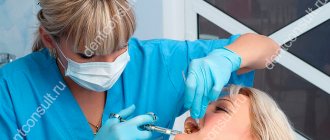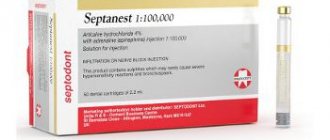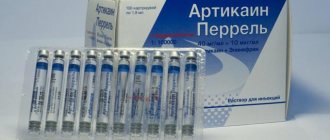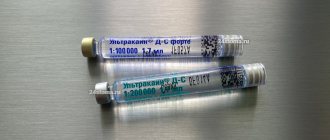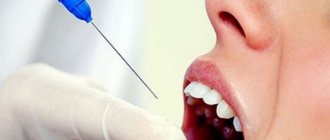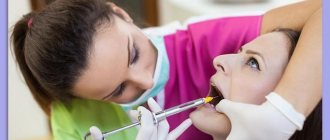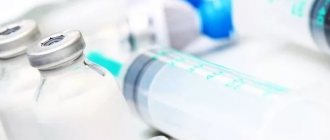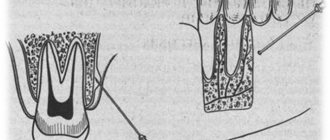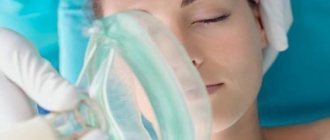What is Articaine and what is its composition?
Articaine is an amide anesthetic intended for local, infiltrative or conductive anesthesia for both simple and complex dental procedures. A local anesthetic blocks the generation and conduction of nerve impulses, presumably by increasing the threshold of electrical excitation in the nerve, slowing the propagation of the nerve impulse, and decreasing the rate of rise of the action potential.
The uniqueness of Articaine as a member of the amide family is that it contains an ester group and a thiophene instead of a benzene ring. The thiophene ring increases the lipid solubility of articaine, facilitating more efficient diffusion of the anesthetic across the lipid membrane of nerve cells into surrounding tissues. Articaine is widely used in dentistry due to its safety during short procedures that require rapid onset of anesthesia.
The onset of action of the drug Articaine is:
- from 1.5 to 1.8 min. with infiltration of the upper jaw;
- from 1.5 to 3.6 min. with block anesthesia of the lower jaw.
Articaine pulp anesthesia lasts from 30 to 120 minutes. Anesthesia of soft tissues with the drug lasts ~ 2.25 hours for infiltration of the upper jaw, 4 hours for blockade of the lower jaw.
The drug is produced in the form of an injection solution - a transparent, colorless or yellowish liquid. For retail sale to pharmacy chains, Articaine is supplied in ampoules made of colorless chemically pure glass, enclosed in blister packs and/or cardboard packs.
Composition of articaine in dentistry:
- active agent - articaine hydrochloride;
- Excipients: sodium chloride (to make the solution isotonic) and distilled water.
1 ml of solution contains 40 mg of active agent.
In odonto-dental anesthesia, articaine is used alone or in combination with epinephrine (adrenaline). Epinephrine, diluted to 1:100,000 or 1:200,000 and added to the solution, slows down the passage of articaine into the general bloodstream and thus ensures long-term maintenance of the concentration of the active substance in the tissues, allowing a small hemorrhagic surgical field to be obtained.
It is possible to replace Articaine with synonyms with the same active substance, such as:
- Artikain-Binergy;
- Ultracaine;
- Artikain-DF;
- Articaine with Epinephrine.
The decision to use analogues is made by the attending physician, taking into account the individual characteristics of the patient.
The choice of anesthetic in dental treatment
The middle and older generations of our country remember very well the times when the need to seek help from a dentist for the prevention and treatment of teeth was associated with the unpleasant feeling of severe and difficult-to-bear pain awaiting the future patient, and therefore a visit to the doctor was made only in cases of the most extreme and urgent need. Modern dentistry, unlike the level of dentistry of the 80-90s of the last century, is much better armed. The most popular anesthetic in dentistry of the past, novocaine, is irretrievably becoming a thing of the past and has been replaced by new drugs that are less toxic and more effective.
When choosing an anesthetic, important indicators are:
- effectiveness of pain relief
- good tissue permeability and long-lasting analgesic effect of the drug
- minimal toxicity and safety of the drug
Since almost all modern drugs are quite effective, the most important point when choosing an anesthetic is its safety.
No less important when choosing an anesthetic is its relationship to the vasoconstrictor (a drug that narrows blood vessels, which leads to a decrease in blood flow in them and prolongs the effect of the drug) - adrenaline. For many patients with pathologies of the cardiovascular system, with endocrine pathologies, patients with bronchial asthma and other diseases, vasoconstrictor-adrenaline is contraindicated. In addition, adrenaline itself maintains a high level of stress, which is undesirable during treatment.
The most popular and corresponding to the above requirements are the following anesthetics:
- Ultracaine DS forte
- Ultracain DS
- Scandonest SVC
Ultracaine DS forte and Ultracaine DS The main anesthetic substance for these drugs is Articaine, which is 2 times more effective than lidocaine and 6 times more effective than novocaine. The drug is completely excreted from the body and is non-toxic, since it does not contain parabens (anesthetic preservatives), there is practically no allergic reaction to the substance and, according to clinical studies, the drug is safe in 99.4% of cases. The main advantages of the drug are:
- high efficiency of the drug with a low degree of toxicity
- almost instantaneous effect of the drug (from 30 seconds)
- safety of the drug for pregnant and nursing mothers, as well as for preschool children
- The duration of anesthesia depends on the anesthesia technique used by the doctor (from 1.5-2 hours when treating one tooth and up to 5-6 hours for more complex dental treatment methods).
Teeth to which standard therapy is applicable are best anesthetized with Ultracaine DS with a minimal content of adrenaline. The effectiveness of the drug is quite sufficient for a fairly long operation, and only in difficult cases is it recommended to use Ultracain DS Forte with a higher concentration of the vasoconstrictor.
Scandonest SVC This drug is recommended for patients for whom the vasoconstrictor-adrenaline is strictly contraindicated (patients with pathologies of the cardiovascular system, etc.) since it itself has a vasoconstrictor effect and therefore can be used without adrenaline.
Manufacturers Articaine
On the Russian pharmaceutical market, the anesthetic Articaine and its analogues are represented by domestic and foreign manufacturers. You can buy articaine in St. Petersburg and Moscow using the link.
The products of the following enterprises are most in demand:
- JSC "Biokhimik" (Russia);
- CJSC "Binergy" (Russia);
- LABORATORY INIBSA, SA (Spain);
- Welfarm LLC (Russia);
- Armavir biofactory FKP (Russia);
- Borisov Medical Preparations Plant (Republic of Belarus);
- Sanofi-Aventis Deutschland GmbH (Germany).
Preparations based on articaine, created at different enterprises, may have certain differences due to production technology, quantitative and qualitative composition of excipients, but at the same time retain the main direction of action of the active substance.
What types of anesthesia are there?
There are two main types of anesthesia: general and local. General anesthesia ( or anesthesia) is used extremely rarely in dentistry With this type of anesthesia, the patient “falls asleep” during the procedure, i.e. is unconscious and feels nothing. Anesthesia can be used for major operations in the oral cavity or in pediatric dentistry. However, due to the presence of a large number of contraindications and possible complications after anesthesia, preference is always given to local anesthesia.
Local anesthesia In this case, pain sensitivity is temporarily disabled only in a certain area of the oral cavity. Tactile sensitivity is usually preserved during local anesthesia; the patient can feel touch or pressure on the tooth and gum, vibration, etc. But pain is completely absent.
To anesthetize a tooth in the upper jaw, it is enough to make several injections into the gum next to the tooth (the so-called “ infiltration” anesthesia In order to numb the lower tooth, it is sometimes necessary to inject an anesthetic near the mandibular nerve (this is “ conduction” anesthesia During conduction anesthesia, half of the lower jaw and tongue become numb. In addition, there is the so-called “ application” anesthesia This anesthesia is most often used before infiltration so that the needle insertion is painless.
Articaine: side effects
Such qualities of Artican as low fat solubility, high% binding to blood proteins, low half-life ensure low toxicity of the drug. However, depending on the general condition, age, individual reactions of the patient and his existing systemic diseases, side effects may be observed during anesthesia with the drug, such as:
- disturbance or confusion;
- vertigo;
- headache;
- nausea;
- dyspnea;
- decreased blood pressure;
- diplopia;
- muscle tremors;
- allergic and local reactions, manifested in symptoms of urticaria, conjunctivitis, rhinitis, skin hyperemia, swelling and inflammation at the injection site.
Articaine should be used with caution during dental procedures in patients with impaired cardiovascular function, vascular diseases, liver and kidney failure.
Articaine
Overdose symptoms
From the central nervous system
Excitation of the central nervous system: feelings of anxiety, fear, confusion, hyperpnea, tachycardia, increased blood pressure with facial flushing, nausea, vomiting, tremor, twitching, tonic-clonic convulsions.
Central nervous system depression: dizziness, hearing impairment, loss of ability to speak, stupor, unconsciousness, atony, vasomotor nerve paralysis (weakness, pallor), shortness of breath, death from respiratory paralysis.
From the cardiovascular system
Bradycardia, arrhythmia, ventricular fibrillation, drop in blood pressure, cyanosis, cardiac arrest.
Treatment
At the first manifestations of intoxication or side effects of the drug, such as dizziness, motor agitation or stupor during drug administration, its administration should be stopped and the patient should be transferred to a horizontal position with the lower limbs raised. The airway should be maintained and hemodynamic parameters (heart rate and blood pressure) monitored.
It is always recommended, even if the symptoms of intoxication seem mild, to free access to the veins in order to be able to immediately administer the necessary medications intravenously, if necessary.
In case of breathing problems, depending on their severity, oxygen supply is recommended, and if there are indications for artificial respiration, endotracheal intubation and artificial ventilation of the lungs are recommended.
Muscle twitching and generalized cramps can be stopped by intravenous administration of fast-acting drugs that have muscle relaxant and anticonvulsant effects (for example, diazepam, suxamethonium chloride). Mechanical ventilation (oxygen supply) is also recommended.
A sharp decrease in blood pressure, bradycardia or tachycardia can often be eliminated by simply moving the patient to a horizontal position with the lower limbs elevated.
In case of severe circulatory disorders and shock, regardless of their cause, the drug should be discontinued and the patient should be transferred to a horizontal position with the lower limbs elevated. Oxygen should be supplied, intravenous administration of electrolyte solutions, glucocorticosteroids (for example, 250 - 1000 mg of prednisolone or an equivalent amount of its derivative, for example, methylprednisolone), infusion replacement therapy (if necessary, additionally, a plasma substitute, including human albumin).
With the development of collapse and increased bradycardia, epinephrine (adrenaline) is immediately administered intravenously. After diluting 1 ml of 0.1% epinephrine solution (1:1000) to 10 ml or, using 0.01% epinephrine solution (1:10000), slowly intravenously administer 0.25-1 ml (0.025-0.1 mg epinephrine), controlling heart rate and blood pressure (caution: heart rhythm disturbances are possible!).
Do not exceed a single intravenous dose of 1 ml (0.1 mg epinephrine).
If subsequent doses greater than 0.1 mg are required, epinephrine should be administered by infusion, adjusting the rate of administration while monitoring heart rate and blood pressure.
Articaine during pregnancy in dentistry
Articaine is usually well tolerated at all stages of pregnancy. There is no data on the long-term effects of the drug on the neurophysiology of the newborn. Also, no teratogenic damage was observed after use of the drug in the first trimester.
There are no data from clinical studies of the penetration of Articaine into breast milk. To minimize possible risk to the baby, breastfeeding mothers may choose to express milk for approximately 4 hours after the injection. After which breastfeeding can be resumed.
Instructions for use
To exclude or minimize intravascular administration of Articaine, an aspiration test is required before using the drug. An accurate and slow technique for injecting the drug is required with control of the pressure on the syringe plunger depending on the sensitization of the tissue.
The instructions for use in dentistry recommend using Articaine in a dosage corresponding to the nature of the manipulation:
- 1.7 ml of solution per tooth for uncomplicated extraction of the upper jaw tooth;
- 0.1 ml for anesthetizing incisions when creating a palatal depot and suturing;
- 0.5-1.7 ml per tooth for grinding teeth for crowns and in case of cavity preparation.
After each injection of Articaine, careful and constant monitoring of vital signs of the cardiovascular and respiratory systems (adequacy of ventilation) and the patient’s state of consciousness should be carried out.
using Articaine in dentistry for infiltration anesthesia during extirpation of mandibular premolars.
Articaine INIBSA
For uncomplicated extraction of teeth in the upper jaw in the absence of inflammation, 1.8 ml of the drug (for each tooth) is usually injected into the submucosa in the area of the transitional fold on the vestibular side. In some cases, additional administration of 1 ml to 1.8 ml of the drug may be required to achieve complete anesthesia. In most cases, there is no need to perform painful injections on the palatal side. For anesthesia for palatal incisions and suturing to create a palatal depot, about 0.1 ml of the drug per injection is required. When removing several adjacent teeth, the number of injections can usually be limited. In the case of removal of mandibular premolars in the absence of inflammation, mandibular anesthesia can be dispensed with, since infiltration anesthesia provided by an injection of 1.8 ml per tooth is usually sufficient. If this method fails to achieve the desired effect, an additional injection of 1 - 1.8 ml of the drug should be performed into the submucosa in the area of the transitional fold of the mandible on the vestibular side. If in this case it was not possible to achieve complete anesthesia, it is necessary to block the mandibular nerve.
To prepare a cavity or prepare a crown for any tooth, with the exception of lower molars, administration of the drug in a dose of 0.5 ml to 1.8 ml per tooth according to the type of infiltration anesthesia from the vestibular side is indicated. The exact amount depends on the desired depth and duration of the procedure. When performing one treatment procedure, adults can be administered up to 7 mg of articaine per 1 kg of body weight. The duration of anesthesia during which the intervention can be performed is 30-45 minutes.
For children
the drug is administered in quantities that depend on their age, body weight and method of anesthesia. The drug should not be used in children under 4 years of age.
For children aged 4 to 12 years, the dose of the administered drug is set to no higher than 5 mg of articaine per kilogram of body weight.
For children weighing from 20 to 30 kg, the recommended dose of the drug is from 0.25 to 1 ml (from 1/6 to 1/4 cartridge). The maximum single dose of the drug should not exceed 1.5 ml. The daily dose should not exceed 2.5 ml.
For children weighing from 30 to 45 kg, the recommended dose of the drug is from 0.5 to 2 ml (from 1/3 to 1 cartridge). The maximum single dose of the drug should not exceed 2 ml. The daily dose should not exceed 5 ml.
Articaine in pediatric dentistry
The pharmacodynamics of local anesthetics in children is comparable to that in adults. In pediatric dental practice, extreme caution must be exercised when using amide local anesthetics as lower intrinsic clearance or decreased serum protein binding may easily lead to an increased risk of toxic reactions. The route of administration is one of the main safety factors when using local anesthetics in neonates and children.
Anesthesia in dentistry with the drug Articaine , carried out using intraosseous injection, is effective in achieving deep anesthesia of teeth affected by MIG with hypersensitivity associated with chronic inflammation of the pulp in children.
In pediatric dentistry, it is recommended to use Articaine 2% due to the lower Cmax and shorter half-life of the drug.
Articaine/ultracaine (ubistezin, septanest) (c68), IgE
Articaine is classified as a 5th generation anesthetic used for conduction and infiltrative anesthesia, mainly in dentistry. As a local anesthetic, articaine, better known as ultracaine, can cause an allergic reaction.
In the group of drug allergies, it is customary to pay special attention to anesthetics, antibiotics, and NSAIDs, since these drugs most often cause certain side effects in the form of allergic phenomena. In this case, Ultracaine is least likely to cause the development of allergies, but if this happens, the manifestations are usually local - itching of the skin, rash, redness in the area where the drug was administered. Severe allergic manifestations, such as anaphylactic shock and angioedema, are practically excluded. However, people suffering from an increased immune response, having a burdened allergic history, namely those suffering from atopic dermatitis, food allergies, hay fever, bronchial asthma, are more likely to experience side effects of the necessary anesthesia. Therefore, in such cases, it is better to assess in advance the degree of risk of developing a response to the administration of drugs by taking a blood test for an allergy to articaine
/ultracaine.
There are 4 types of allergic reactions, but only 1 type or an immediate reaction, which includes anaphylactic shock, is manifested by the appearance of class E immunoglobulins in the blood. This type is quite common, an example of which can be various dermatitis in response to consumption or contact with an allergen. Typically, such reactions develop quite quickly, which is where the name “immediate type” comes from. Thus, to the introduction of anesthesia, a response in the form of a series of reactions can develop quite quickly. In the case of ultracaine administration, the development of anaphylactic shock is practically excluded, which made it possible to introduce this drug into widespread practice, making it the drug of choice for conduction and infiltrative anesthesia in dentistry.
We should not forget about the mechanism of the immune response. Thus, sensitization occurs at the first contact of the body with an allergen, in response to which antibodies are produced. When you meet again, you can observe clinical manifestations of the development of an allergic reaction, because the allergen in this case enters an already sensitized body and is attacked by antibodies. Immunoglobulin E is necessarily produced upon the first contact with an allergen, being a link in the chain of development of the immune response.
Reviews from dentists about the drug Articaine
Most practicing dentists consider Articaine to be the best representative of local anesthetics due to its high effectiveness. At the same time, when using the medication, there is a low incidence of allergic reactions, the possibility of safe use in pregnant women, and the absence of addiction. The only small drawback of Articaine, according to experts, is the inability to prescribe it to children under 4 years of age. In all other cases, Articaine is rightly called one of the drugs of choice.
This information is intended for medical professionals and specialists.
